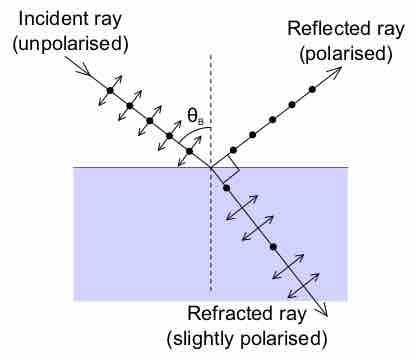Brewster's angle (also known as the polarization angle) is an angle of incidence at which light with a particular polarization is perfectly transmitted through a transparent dielectric surface, with no reflection. When unpolarized light is incident at this angle, the light that is reflected from the surface is therefore perfectly polarized. This special angle of incidence is named after the Scottish physicist Sir David Brewster (1781–1868).
The physical mechanism for this can be qualitatively understood from the manner in which electric dipoles in the media respond to p-polarized light (whose electric field is polarized in the same plane as the incident ray and the surface normal). One can imagine that light incident on the surface is absorbed, and then re-radiated by oscillating electric dipoles at the interface between the two media. The refracted light is emitted perpendicular to the direction of the dipole moment; no energy can be radiated in the direction of the dipole moment. Thus, if the angle of reflection θ1 (angle of reflection) is equal to the alignment of the dipoles (90 - θ2), where θ2 is angle of refraction, no light is reflected.

Fig 1
An illustration of the polarization of light that is incident on an interface at Brewster's angle.
This geometric condition can be expressed as
When light hits a surface at a Brewster angle, reflected beam is linearly polarized. shows an example, where the reflected beam was nearly perfectly polarized and hence, blocked by a polarizer on the right picture. Polarized sunglasses use the same principle to reduce glare from the sun reflecting off horizontal surfaces such as water or road.

Fig 2
Photograph taken of a window with a camera polarizer filter rotated to two different angles. In the picture at left, the polarizer is aligned with the polarization angle of the window reflection. In the picture at right, the polarizer has been rotated 90° eliminating the heavily polarized reflected sunlight.